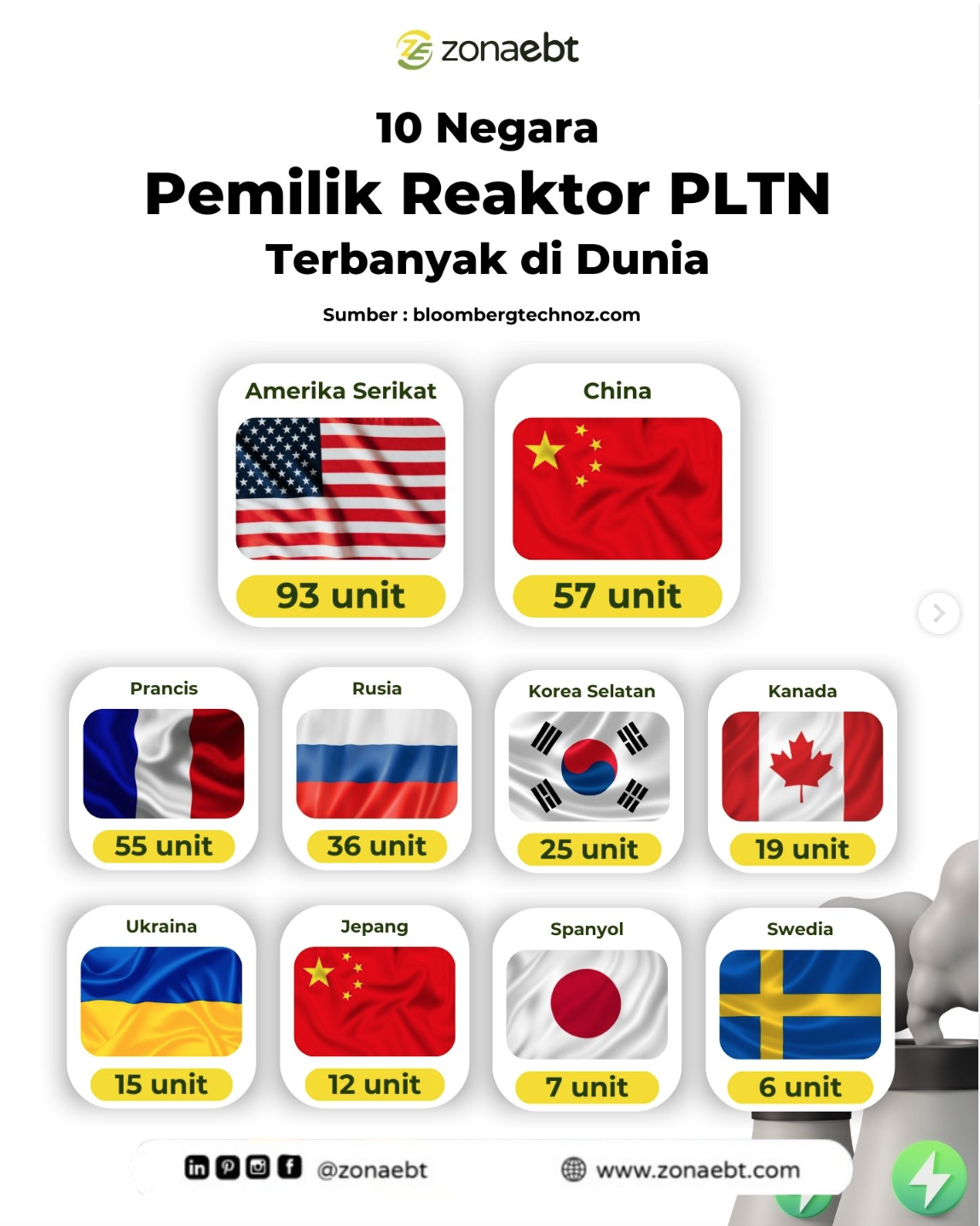
- China has become the second country in the world with achievements in nuclear energy development.
- The world’s nuclear development has experienced a relatively modest increase in the last few decades. This creates challenges from other renewable energies such as wind and solar, which have actually increased drastically.
- As of 2024, the number of nuclear reactors worldwide is estimated to be 408 nuclear reactors, spread across 32 countries.
In 2024, the World Nuclear Report provided an update on the global status of nuclear energy. By early 2025, there were approximately 408 operational reactors across 32 countries, marking a decrease of one reactor compared to 2023. Despite this slight reduction, the net power generation capacity rose from 364 GW in 2023 to 367.3 GW by mid-2024.
Globally, nuclear facilities generated 2,602 TWh (billion kilowatt-hours) of electricity in 2023. China maintained its position as a leader in nuclear energy production, surpassing France for the fourth consecutive year. The rapid expansion of China’s nuclear program has solidified its position as a major player, with projections indicating it could soon rival the United States, the current leader in nuclear energy. While nuclear production globally increased by 2.1 percent in 2023, this growth has been relatively modest over recent years.
How does nuclear energy development vary worldwide? Below is a closer look at the countries with the most nuclear reactors and their contributions to global nuclear energy.
Baca Juga
- Nuklir Energi Paling Bersih? Simak Alasannya!
- Evolusi Teknologi Reaktor Nuklir, Perjalanan dari Masa ke Masa
Nuclear Opportunities Against Other Renewables

According to the annual report, there is a clear downward trend in the dominance of fossil fuels globally. By 2023, the use of renewable energy surged to record levels, largely driven by China and other developed nations. Renewable energy continues to outperform nuclear power in terms of cost-efficiency and speed of deployment. However, nearly every country is also competing to expand nuclear energy development, recognizing its potential as a reliable energy source to complement renewables.
The world’s shared commitment to accelerate the adoption of renewable energy is a mandate from the COP-28 Summit in 2023, which targets the world to reach zero emissions by 2050. Tripling the efficiency and use of renewable energy by 2030 will put emissions back on track to meet the Paris Agreement’s 1.5 degree target.
In realizing the world’s joint commitment, nuclear is not necessarily the first choice for countries that are making a renewable energy transition. Given the ability of each country to develop nuclear energy is not always the same and uniform. Glancing at the report, we can see that the installed nuclear capacity only stays at 95-100. Meanwhile, wind and solar renewable energy installations continue to experience an upward trend from year to year.
The amount of operating nuclear capacity began to be overtaken by wind power in 2019 and solar power in 2022; in comparison, electricity production from nuclear remained ahead of wind and solar power. In 2023, nuclear energy produced about 1.8 times more electricity than wind energy and 3.3 times more than solar energy. It is possible that wind and solar energy could match the energy production produced by nuclear, given their significant development. If we accumulate their energy production, it already represents 85.5 percent of nuclear production in 2023.
As the owner of the most reactors as of 2024, the US has promising prospects for a more sustainable and resilient energy system through strong policy support and continued technological advancement. Expanding grid capacity and improving storage solutions will be critical in managing the increasing share of intermittent renewable energy sources. As investments in renewable energy continue, it is expected that renewable energy will play an increasingly dominant role in the US electricity generation mix in the coming years. By 2023, active capacity awaiting grid connection includes more than 1 TW of solar, more than 1 TW of storage, and 366 GW of wind power, according to a Lawrence Berkeley National Laboratory study.
Baca Juga
Countries With the Largest Nuclear Infrastructure

- China
Nuclear power generation saw an increase of 2.8 percent, after the biggest jump in 2021 of 11 percent. China currently has 58 nuclear reactors in active operation, with another 29 under development. Meanwhile, in line with the development of nuclear energy, China’s nuclear capacity grew by 1 GW. Launching from the World Nuclear Association, it is currently working to build 30,000 Megawatts, leading the world’s nuclear capacity construction. Currently, China already has nuclear facilities with a capacity of 57,000 Megawatts. Even so, the amount of energy produced by nuclear plants is still inferior to other renewable energy. Non-hydro renewables generate 17.6 percent of the nation’s gross electricity generation, 3.6 times more than nuclear’s contribution.
- France
After a massive downturn in 2022 (annus horribilis), nuclear power generation recovered by 15 percent, but is still far from the 400 TWh that was considered normal a decade ago. Nuclear power represents 65 percent of total electricity generation but only 16.3 percent of final energy. France currently has 63,000 Megawatts of nuclear capacity, second only to the US. However, the pace of nuclear plant development in France still lags behind other countries, it is recorded that by 2024 France will have no nuclear reactors under construction. As of this year, France is stuck at 57 operating nuclear reactor facilities.
- Japan
Currently, Japan has nuclear facilities that have a capacity of 31,000 Megawatts, and is planning the construction of an additional 2,000 Megawatts of capacity. Two additional reactors were restarted in the second half of 2023 bringing the total to 12 operating units while 21 reactors remain in LTO. The total number of nuclear reactors Japan has is 33 active reactors. Nuclear power generation saw a 49 percent surge, but the mix of nuclear energy in total electricity fell slightly, from 6.1 percent to 5.6 percent. The earthquake on the Noto Peninsula (January 1, 2024), which registered a magnitude of 7.6, caused damage to the Shika nuclear power plant, which has been closed since 2011.
- Russia
Seventy years ago, in 1954, the Soviet Union/Russia became the first country to initiate the development of nuclear power plants into the commercial grid. The Russian nuclear reactor company Rusatom is currently the manufacturer of 26 nuclear reactors. Today, Russia is the world’s leading nuclear power plant builder with 36 nuclear reactor units in operation by 2024, with 2 reactors under construction. Notably, Russia has nuclear facilities with a capacity of 26,000 Megawatts.
- South Korea
The country operates the fifth largest nuclear power reactor (by capacity and production) in the world. The 26 operating nuclear reactors produced a record 171.6 TWh in 2023. With these 26 reactors, South Korea has a total nuclear energy capacity of 25,000 Megawatts. To increase nuclear energy production, South Korea is building an additional 2,600 Megawatts of capacity. The national nuclear company responded to requests for tenders for reactor construction in various countries, but declined to disclose financial records on its only previous foreign deal with the UAE.
- Sweden
Nuclear power generation decreased by 6.7 percent, reaching 47 TWh which accounts for less than 29 percent of national electricity production. Currently, Sweden has 6 nuclear reactors still in active operation. The current government is determined to relaunch a nuclear new-build program that will result in at least 2.5 GW of new capacity on the grid by 2035. However, so far, no design, supplier or site has been selected, and no financial package has been developed. In addition, Sweden also has no projections for the construction of additional nuclear reactors in the coming years.
- Ukraine
Of the 15 reactors still in operation, six are at the Zaporizhzhia site, which Russia is still invading; in fact, the reactors have been shut down for almost two years. Reactors still in operation are a constant cause for concern in a country engaged in a major war. At 51 percent, Ukraine remains the country with the third highest share of nuclear power in total electricity generation in the world. Ukraine now has active nuclear facilities with a capacity of 13,000 Megawatts. It is projected that Ukraine will build an additional 2,000 Megawatts of capacity with the construction of two additional reactors.
- USA
The US leads the world in nuclear energy production. They are capable of producing up to 96,000 Megawatts of energy. The nuclear share of commercial power generation increased by 0.4 percentage points to 18.6 percent. The US nuclear fleet is still the largest in the world, with 94 units, and also one of the oldest with an average age of 42.7 years. However, despite having the world’s highest nuclear reactor facilities, the pace of American nuclear energy development has not grown over the past few decades. Will China overtake the US in this regard?
In the Global Nuclear Race, How is China Rapidly Advancing?

Until 2025, China has a total of 58 power plants with 57GW in operation and 29 under construction with 24 GW. About 5% of the country’s electricity comes from nuclear energy, amounting to 348.1 TWh in 2019. China is cautiously optimistic and carefully considering accelerating the development of nuclear power as an alternative to coal, given growing concerns about air quality, climate change and fossil fuel shortages. China General Nuclear Power Group has put forward projections by 2035 of building 150 additional reactors.
China has two sizable nuclear power companies, the China National Nuclear Corporation which operates primarily in northeast China, and the China General Nuclear Power Group (formerly known as China Guangdong Nuclear Power Group) which operates in southeast China.
China is ambitious to continue maximizing self-reliance in the manufacture and design of nuclear reactor technology, although it currently relies to some extent on international cooperation and technology transfer. In addition to actively building nuclear infrastructure, China is also vigorously conducting market research and management. China is involved in the development of nuclear fusion reactors through its participation in the ITER project, as well as research and development of the thorium fuel cycle as a potential alternative means of nuclear fission. In general, the development of China’s capabilities in nuclear energy is partly a significant result of technology transfer and sharing with the US.
Launching from the Information Technology & Innovation Foundation (ITIF), China is currently carrying out various revolutionary strategies to pursue nuclear development in the coming years. This, according to some experts, is the main cause why China is currently leading in terms of the construction of the most massive nuclear reactors among other countries. Including in terms of increasing the intensity of research on nuclear. In 2022, China ranked third among the top 10 percent of most cited publications in nuclear science and engineering, with 339 publications. The number of publications in China quadrupled between 2008 and 2021, while European publications decreased by almost a quarter and the number of American publications decreased by a fifth.
China is also highly adaptive to the latest generation of nuclear reactor technology, the fourth generation. Currently, China is in the process of deploying six types of fourth-generation nuclear reactors identified by the Generation IV International forum. The Chinese government has also set a goal to build the first industrial fusion reactor prototype, dubbed “artificial sun,” by 2035, with officials hoping to begin large-scale commercial fusion energy production by 2050. With such innovations, China could become a major US competitor in nuclear development.
zonaebt #EBTHeroes #Sebarterbarukan
Editor : Alfidah Dara Mukti
Referensi :
[2] The Global Race for Advanced Nuclear Is On


